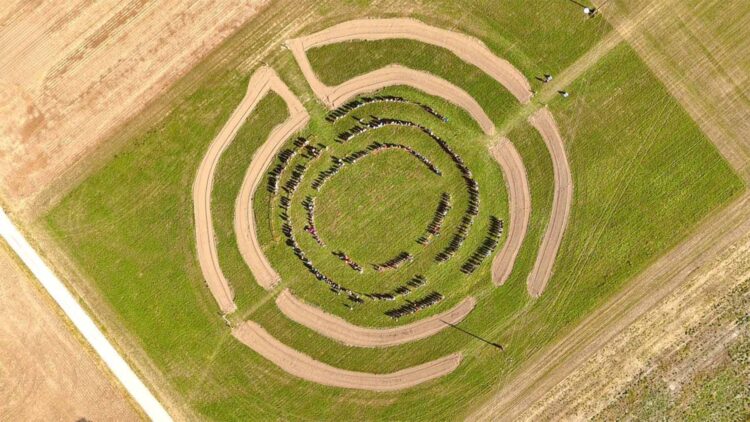Something that initially looked like signs from aliens has been discovered in a quiet field in Burgenland, close to the Hungarian border, in Austria: Amazing circular footprints that date to the Neolithic, some 2,000 years before Stonehenge, have been found in the soil at Rechnitz.
The astounding discovery, which was first reported by Artnet News, shows that precise archaeology has located ancient human settlements in Central Europe.
The circles, which have a diameter of almost 107 meters, date from a period when hunter-gatherers gave way to a Neolithic society based on agriculture and animal husbandry. “The Rechnitz site can be considered a supra-regional centre of the Middle Neolithic. (…) Due to the existence of three of these monumental structures dating from the fifth millennium BC, very close to each other,” writes Nikolaus Franz, director of Archaeology at Burgenland. There, the Stone Age is revealed as a dynamic time of transition.
Maps of a changing world in circles
In Rechnitz, the rings are big, purposeful, and old. Their size suggests preparation and cooperation, which are characteristics of the Neolithic, a time when societies organized work, molded terrain, and constructed significant locations. The “Middle Neolithic” dating, that places them around 2,000 years before Stonehenge, grounds them in a regional tradition that corresponds to fifth-millennium BC Central Europe.
Three colossal buildings near one another have been discovered by archaeologists, validating the concept of a regional center. “The Rechnitz site can be considered a supra-regional centre of the Middle Neolithic. (…) Due to the existence of three of these monumental structures dating from the fifth millennium BC, very close to each other.” Pits, holes, and pieces of pottery are examples of ground evidence that add texture and show daily activities and periods in construction.
Certain features are Early Neolithic, while others are Middle Neolithic, showing intergenerational continuity and recycling.
Hunter-gatherers to settlers
During this time rhythm and food changed. Hunter-gatherers’ nomadic lifestyles of tracking game and gathering wild plants gave way to settled lives centered on fields, herds, agriculture, and animal husbandry.
A new relationship with land, planning, storage, and shared labor were all developed by that change. “We are learning a lot about the Neolithic settler clans who found this place a suitable site to establish the cultural techniques of agriculture and animal husbandry in what is now Burgenland in the fifth millennium BC. After centuries of hunting and gathering, the gradual settlement of humans was truly revolutionary,” writes Nikolaus Franz.
These circles help in visualizing that change. Their size suggests collaboration and a common goal. Everyday life can be seen in the pottery and excavated features. When taken as a whole, they suggest that early human settlements served as both social landmarks and functional bases, working as gathering places and seasonal cycle indicators.
Experimentation, adaptation, and constant growth
The Neolithic feels tangible and intimate thanks to discoveries like Rechnitz. What at first could have seen like something would develop in aliens research, show the formation of early human settlements, the gradual adoption of agriculture and animal husbandry by hunter-gatherers, and the coordination of communities around common projects that made long-lasting footprints on the soil. The site’s chronology, which spans the Early and Middle Neolithic periods, gives it complexity, and its size allows us to envision the collaboration and planning that went into it.
Most importantly, the discovery encourages a liberal view of the past. Instead of stagnation, we see the Stone Age as a time of experimentation, adaptation, and continuity. The circles reveal how people organized their lives, exchanged knowledge, and created important places.
Everything in this place, from the massive rings in Rechnitz to the modest pottery shards, suggests a tale of perseverance and creative thinking.

